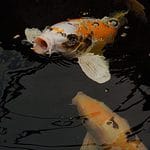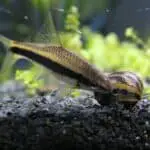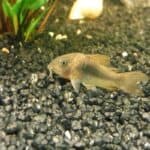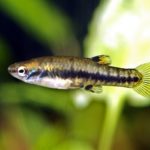Aquariums up to 10 gallons are considered nano aquariums. In addition to the small space available, these small systems can vary parameters abruptly.
That’s why it’s necessary to choose hardy fish species that thrive in small spaces. Several species are easy to care for and will do well in 10 gallon aquariums.
This guide lists the 12 best fish for 10 gallon tank and tips for successful fish keeping.

What You Need to Know When Stocking 10 Gallon Fish Tanks
When stocking a 10 gallon tank, it’s essential that you keep a few things in mind, especially if you’re a novice aquarist.
Small aquariums, the so-called Nanos, are less stable due to their small volume of water and may vary their parameters quickly. When choosing your first aquarium, the ideal is to have a capacity of around 25 gallons; these aquariums are more stable and housing a greater amount of fish.
On the bright side, fish comprise a complex and diverse group of vertebrate animals. Because it is such a diverse group, it is easy for us aquarists to choose resistant fish, easy to care for, and adapt well to small aquariums.
No matter how small, the aquarium should always have the basic equipment. You must have at least one filtration system and one heater. These pieces of equipment are essential to support the lives of the inhabitants.
It can be challenging to choose a filtration system for aquariums of this size. Among the many options, mini canisters and HOB filters are ideal. They are compatible with the volume of water and are allocated externally, which leaves more free space inside the tank.
Sponge-type filters are very efficient, but they take up a certain amount of space on display, reducing the useful volume used by the fish. This type of filter is best when used in fry tanks.
The heater will be responsible for keeping the system temperature stabilized. The key to the aquarium’s success is stability; the heater will always keep the water heated at a predetermined temperature.
The placement of the aquarium is important. Because it has a small volume of water, the 10-gallon aquarium should not be placed in places where extreme temperatures occur, such as directly in the sun. Very busy places can also stress the fish. Place your aquarium in a quiet location.
As small aquariums are small, when assembled with the equipment, substrate, and decorations, these aquariums have a considerable weight. Always place the aquarium on a flat surface that can support its weight.
A large part of the problems that aquarists face in their activity concerns the health of the water they keep in their tanks. Maintaining good water quality becomes even more vital in 10-gallon aquariums. Hence the constant struggle of aquarists to maintain good water quality.
The good quality we mentioned is not that the water is transparent and odorless, but that it is biologically suitable for aquatic animals. And being a closed system, you are the one who will always make the system perfect through periodic maintenance.
These maintenances include partial water change, substrate siphoning, glass cleaning, filters, and decorations. Maintenance must be carried out periodically. Ideally, they should be done weekly.
Remove any leftover ready-to-eat leftovers in the aquarium, on the bottom or on the surface. Excess food degrades water quality, making the environment toxic, acidifying and clouding the water.
Pay attention to the correct water flow and proper functioning of the filter. Excessive movement (strong flow) can harm the life of the aquarium, not only stressing the fish and plants but also the bacteria.
Daily check the correct operation of pumps, heaters and other equipment.
Finally, even with all these precautions to maintain healthy water in aquariums, we must always be aware of its parameters, which must be routinely measured. Another fact that deserves mention is always to have common sense in the amount of fish to be kept in the middle. The recipes given here may not be very new to some, but they can greatly benefit many friends who want to achieve success and satisfaction in raising ornamental fish.
How Many Fish Can You Have In A 10 Gallon Tank?
This is probably the question that most interests all aquarists. The answer to this is that it depends on a few factors, mainly the fish species.
Some fish, such as male Betta, are solitary and should be kept alone in a 10-gallon tank. Tetras are schooling fish, so we should always keep at least 4 to 6 individuals.
The main thing is that you always use common sense. Through observation, you can verify that all fish have space to swim freely, hide, and form territories.
In addition to the physical space, the big problem with these small aquariums is that the water degrades quickly. That is why we must maintain a low population of inhabitants. Perform tests constantly in your aquarium; if they always give very altered results, reduce the population of fish and invertebrates.
Debunking The One Inch Fish Per Gallon Rule
Unfortunately, in the aquarium hobby, many outdated concepts are still reproduced as being true. The one-inch of fish per gallon rule is one of them.
The best representation to explain why this rule is flawed is to take a large fish as an example. We will talk about an Arowana 24 inches in diameter. By this rule, we could keep this fish in a 24-gallon tank.
Well, a fish 24 inches long would barely be able to turn its body, as the width of this aquarium would be less than its length.
The rule is so without merit that the correct thing when we talk about fish maintenance is to talk about tank measurements, not volume. This is because different fish have different habits and needs. Some fish do not require a water column height, while others do well in thin aquariums.
We use volume as a standard measure to facilitate understanding, but the correct thing will always be to provide, along with the volume, the spatial need for the species to maneuver and use. As in the case of the Arowana, which needs a wide and long aquarium.
Ultimately, there is no general rule for keeping fish. Because they are a diverse group (again), we have to look at the individual needs of each species and their tankmates.
How To Determine The Best Fish For 10 Gallon Tank
When thinking about populating a 10 gallon aquarium, we must carefully analyze the requirements of the species we want to keep.
Small species are essential; otherwise, the fish will not be able to inhabit a small aquarium. The total size of the species as an adult must be considered. Many aquarists keep large species in small aquariums, thinking that the fish will not grow because there is no space; this is untrue.
In such cases, the fish will atrophy and lead a sad and suffering life. Never buy a fish thinking of getting rid of it when it gets too big for the tank. This is irresponsible, as you cause the animal unnecessary suffering.
Opt for fish that are simple to care for. Some species need very specific or even extreme environments, something difficult to reproduce in small-volume tanks.
Some species, even though they are not large, need a large available space. This is because they are very active or have some special needs. For example, we can mention some Plecos, which, however small, need an aquarium with a good biofilm index and available space.
Some fish are known to eat a lot and produce a lot of bioload through their feces, urine, and breath. These species should be avoided at all costs. Here are included fish like Goldfish and even some snails.
The Best Fish For 10 Gallon Tank
Here are 12 species that we consider the best to be kept in aquariums around 10 gallons in volume.
1. Betta
One of the most classic fish for a small aquarium. Contrary to what we commonly see, we should never keep these fish in tiny spaces without a filter or heater. A 10 gallon tank is ideal for keeping 1 male Betta alone or with a few Dwarf Corydoras or Red Cherry Shrimps.
Females are less aggressive and can be kept in up to 3 individuals within this volume of water.
| Scientific Name | Betta splendens |
| Size | 2 to 4 inches |
| Number in 10-Gallon Tank | 1 male or 3 females |
| Diet | Carnivore |
| Temperament | Aggressive |
| Lifespan | 2 to 5 years |
| Temperature | 78°-80°F or 25.5°- 26.5°C |
| pH | 6.5 to 7.5 |
2. Celestial Pearl Danio
The Pearl Danio is one of the best for small spaces. They are small-sized fish, reaching around 0.8 inches, and because they are not very active, they adapt very well to small-volume aquariums.
They are schooling fish, so you should keep more than 1 individual. In 10 gallons, you can easily keep up to 8 individuals. Give preference to keep 3 females for each male.
These fish love to be among the vegetation, providing if possible a planted corner.
| Scientific Name | Danio margaritatus |
| Size | 1 inch |
| Number in 10-Gallon Tank | 10 |
| Diet | Omnivore |
| Temperament | Peaceful |
| Lifespan | 3 to 5 years |
| Temperature | 73 – 79 °F or 22 – 26 °C |
| pH | 6.0 to 7.5 |
3. Neon Tetra
Neon Tetra is a classic fish in the aquarium world and a great addition to a small aquarium. As they are shoal, keep around 6 individuals in the aquarium.
This fish is very easy to care for, requiring no extreme or special parameters. They live in warm, slightly acidic, or pH-neutral waters. They are easy to feed, quickly accepting flakes and pellets.
| Scientific Name | Paracheirodon innesi |
| Size | 1.7 inches |
| Number in 10-Gallon Tank | 6 |
| Diet | Omnivore |
| Temperament | Peaceful |
| Lifespan | 3 to 5 years |
| Temperature | 77 – 86 °F or 25 – 30 °C |
| pH | 6.6 to 7.0 |
Read also: 10 Things You Should Know About Neon Tetra Fish
4. Zebra Danio
The Zebra Danio fish is one of the favorites to be used in laboratories, and they are kept dense and in low volume. They are very active fish and live mainly on the surface of the aquarium.
These fish are super resistant and live in different water parameters. Because they are very active, keep a maximum of 6 individuals in 10 gallons.
| Scientific Name | Danio rerio |
| Size | 1.5 inches |
| Number in 10-Gallon Tank | 6 |
| Diet | Omnivore |
| Temperament | Peaceful |
| Lifespan | 5 years |
| Temperature | 70 – 78 °F or 21 – 25 °C |
| pH | 6.6 to 7.5 |
5. Dwarf Corydoras Catfish
Dwarf Corydoras Catfish are small, graceful fish that, unlike other Corydoras, like to swim in the water column. These are schooling fish, and you must keep a group of up to 6 individuals in this small space. They are easy to care for and have very fun behavior, both when they are foraging on the ground looking for food and when they are swimming in the water column.
They are peaceful fish which can be kept without problems, along with shrimp or even Betta.
| Scientific Name | Corydoras hastatus |
| Size | 1.5 inches |
| Number in 10-Gallon Tank | 6 |
| Diet | Omnivore |
| Temperament | Peaceful |
| Lifespan | 3 to 5 years |
| Temperature | 68 – 79 °F or 20 – 26 °C |
| pH | 6.0 to 7.5 |
6. Dwarf Gourami
The Dwarf Gourami are considered dirty animals and are somewhat aggressive. Some people can keep a couple at 10 gallons without problem; however, we recommend keeping just one individual. This is because these fish can become aggressive towards the same species.
It is an incredibly resistant species, which does very well in small spaces and is forgiving with water quality.
| Scientific Name | Trichogaster lalius |
| Size | 3.5 inches |
| Number in 10-Gallon Tank | 1 |
| Diet | Carnivore |
| Temperament | Agressive |
| Lifespan | 5 years |
| Temperature | 80 – 84 °F or 26 – 28 °C |
| pH | 6.6 to 7.5 |
7. Chilli Rasbora
The Chilli Rasbora is a fish that, despite being demanding in terms of water quality and the parameters that must be maintained, is easy to maintain.
Due to its very small size, you should really offer crushed flakes or nauplii food. They are peaceful and of gregarious behavior, being able to be kept in up to 15 fish in 10 gallons. You can keep them together with dwarf shrimp without a problem.
| Scientific Name | Boraras brigittae |
| Size | 0.8 inches |
| Number in 10-Gallon Tank | 15 |
| Diet | Omnivore |
| Temperament | Peaceful |
| Lifespan | 3 to 5 years |
| Temperature | 68 – 82 °F or 20 – 27 °C |
| pH | 6.0 to 7.0 |
8. Guppy
Guppies are another aquarium classic. They are super-resistant fish and can be kept in 10 gallons without problems. I recommend starting with just one trio, two females and one male. They are extremely resistant to different parameters and poor water quality.
This recommendation is because they are very prolific fish, which will reproduce and fill the aquarium promptly. If you want to keep more fish, remember that males constantly harass females, so females should always be in greater numbers.
| Scientific Name | Poecilia reticulata |
| Size | 2.4 inches |
| Number in 10-Gallon Tank | 3 |
| Diet | Omnivore |
| Temperament | Peaceful |
| Lifespan | 3 to 5 years |
| Temperature | 72 – 82 °F or 22 – 28 °C |
| pH | 6.8 to 7.5 |
9. Endler Guppy
Endler Guppies (Poecilia wingei) have many characteristics in common with common guppies (Poecilia reticulata) but are smaller in size, which makes them ideal for keeping in 10-gallon nano aquariums.
Like their cousins, Endlers are available in a multitude of fin colors and patterns.
| Scientific Name | Poecilia wingei |
| Size | 1.4 inches |
| Number in 10-Gallon Tank | 6 |
| Diet | Omnivore |
| Temperament | Peaceful |
| Lifespan | 3 to 5 years |
| Temperature | 72 – 82 °F or 22 – 28 °C |
| pH | 6.8 to 7.5 |
10. Ember Tetra
Ember tetras adapt very well to small spaces and have a beautiful orange-red color. It is this feature that has earned it its popular name. In a 10-gallon tank, keep something around 10 individuals.
These fish don’t produce much bioload, so they can be kept with shrimp and snails.
| Scientific Name | Hyphessobrycon amandae |
| Size | 0.8 inches |
| Number in 10-Gallon Tank | 10 |
| Diet | Omnivore |
| Temperament | Peaceful |
| Lifespan | 3 to 5 years |
| Temperature | 73 – 84 °F or 23- 29 °C |
| pH | 6.6 to 7.0 |
11. Green Neon Tetra
The smallest Neon Tetra species should be kept in predominantly acidic, warm, and soft water. It is an incredible species for a 10 cock biotope-style aquarium and can hold up to 12 fish in that space.
It is easy to feed and is disease resistant. A schooling fish, when swimming makes a beautiful impression with its bright stripes.
| Scientific Name | Danio margaritatus |
| Size | 0.8 inch |
| Number in 10-Gallon Tank | 12 |
| Diet | Omnivore |
| Temperament | Peaceful |
| Lifespan | 3 to 5 years |
| Temperature | 82 – 86 °F or 27 – 30 °C |
| pH | 6.0 to 6.8 |
12. Pea Puffer
The Dwarf Pufferfish should be kept alone in the aquarium. This is because, despite its small size, it produces a large bioload load, rapidly degrading water quality. They are very gluttonous fish, and any other species is likely to be eaten.
It is a territorial and aggressive species.
They need stable parameters, but as long as everything is kept within the ideal, they will not present problems.
| Scientific Name | Carinotetraodon travancoricus |
| Size | 0.9 inches |
| Number in 10-Gallon Tank | 1 |
| Diet | Carnivore |
| Temperament | Territorial |
| Lifespan | 5 years |
| Temperature | 74 – 82 °F or 23 – 27 °C |
| pH | 7.2 to 7.5 |
Fish to Avoid Putting In A 10 Gallon Tank
In the same way, you need to understand what characteristics fish to be kept in 10-gallon aquariums must have. Knowing which factors do not make species able to inhabit this literate is just as essential.
Large Aquarium Fish
Large fish should never inhabit a 10 gallon aquarium. Speaking of size, the biggest fish we can put in an aquarium of this volume should be no more than 5 inches and a sedentary fish.
The ideal aquarium size for a fish allows the species to forage for food, have a space to swim freely, form its territory, feed, and hide. The bigger the species, the bigger the tank we have to give it.
A widespread myth among inexperienced aquarists is the large fish growing in small aquariums. Something like the bigger the tank, the more the fish will grow. Like other living beings, fish have their size, color, shape, and other characteristics determined by their genetic code.
This belief that if the aquarium is small, the fish is small is an old thing, from the time that fish lived for a short time in aquariums. Nowadays, it is normal for different species to exceed their life expectancy.
In small aquariums, large fish will quickly degrade the water quality, directly affecting their growth, causing “stunt growth”, which is nothing more than the fish simply stopping growing.
If the water quality is kept good and the fish can continue growing, it will most certainly be atrophied.
Messy Fish
Messy fish are those fish that produce a lot of bioloads, like Goldfish, Plecos, and Carp. The high amount of organic matter and ammonia produced and excreted is due to the digestive system of these fish.
Due to their long intestines, some fish species constantly feed, always looking for food in the tank and even consuming large amounts. This makes them produce a lot of feces and release an absurd amount of ammonia during breathing.
All these compounds produced by these fish help to degrade water quality, and it is not a problem in large volumes of water with a good filtration system and maintenance up to date.
In the case of 10 gallon aquariums, we will hardly have super-sized filtration to deal with these animals. Likewise, the low volume of water deteriorates quickly.
Keeping one of these fish in a small volume of water means a high rate of water changes, even daily, to keep the water of good quality and the aquarium clean.
Sensitive fish
Due to the low volume of water (only 10 gallons), we should avoid keeping sensitive fish in these aquariums. That’s because they can quickly perish with a slight rise in ammonia or a fluctuation in temperature.
Fish That Live In Extreme Environments Or Conditions
Some fish live in extreme temperature or water flow conditions, such as rapids fish.
These environments and conditions are incredibly difficult to replicate in large aquariums and even more so in 10-gallon aquariums.
Territorial Fish
Territorial species need spacious aquariums. Generally, these fish need different environments in the same aquarium, where in one place, they will explore and feed. In another, they will defend their territory, which can be a cave, a rock, or even a decoration.
In the case of small aquariums, these fish will not be able to have a divided environment, having only the territory determined by them. The fish will then be defending you exhaustively, which will generate stress.
Some schooling fish also show territorial behavior, such as the Sailfin Tetra and Bucktooth Tetra. These fish are sure to kill themselves if kept in a tight space.
Final Thoughts On Best Fish For 10 Gallon Tank
Keeping fish at 10 gallons can be challenging, but as long as you follow some basic rules, like choosing species that don’t generate a lot of bioloads and adapt to small spaces, you’ll have no problems, and your fish will be happy and healthy.
Keeping the maintenance up to date and the aquarium always clean is the key to keeping the aquarium always stable. Always have a filter; filters are like the lungs of the aquarium, an essential piece that must always be present.
Now that you know the best fish to compose a 10 cock aquarium, how about putting the ideas into practice and setting up a new tank?
FAQs
What is the biggest fish you can keep in a 10 gallon tank?
Fish are around 4 inches in sizes, such as Bettas and Dwarf Gourami are suitable for a 10 gallon tank.
How many fish can you keep in a 10 gallon tank?
This is relative to the species you want to keep. But around 16 fish of some small species are ideal, like Chilli Rasbora.
Can a Goldfish live in a 10 gallon tank?
Goldfish are very messy fish that produce many bioloads and grow to very large sizes. They should never be kept at 10 gallons.
References
Conway, K. W., Chen, W. J., & Mayden, R. L. (2008). The “Celestial Pearl danio” is a miniature Danio (ss)(Ostariophysi: Cyprinidae): evidence from morphology and molecules. Zootaxa, 1686(1), 28.
Roberts, H., & Palmeiro, B. S. (2008). Toxicology of aquarium fish. Veterinary clinics of North America: exotic animal practice, 11(2), 359-374.
Rhyne, A. L., Tlusty, M. F., Schofield, P. J., Kaufman, L. E. S., Morris Jr, J. A., & Bruckner, A. W. (2012). Revealing the appetite of the marine aquarium fish trade: the volume and biodiversity of fish imported into the United States. PloS one, 7(5), e35808.








